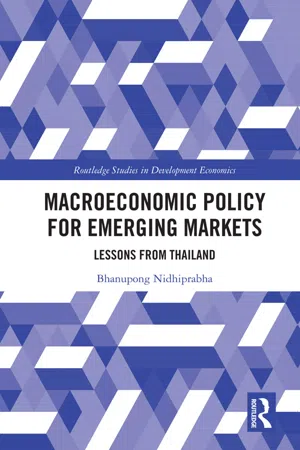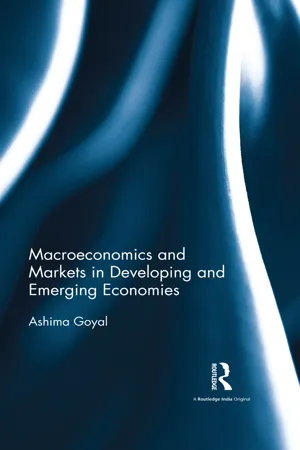Economics
Fiscal Policy Actions in the Short Run
Fiscal policy actions in the short run refer to government decisions to adjust spending and taxation to influence the economy. These actions are aimed at stimulating or slowing down economic activity to address short-term fluctuations in output and employment. By increasing government spending or reducing taxes, fiscal policy can boost demand and support economic growth during downturns.
Written by Perlego with AI-assistance
Related key terms
8 Key excerpts on "Fiscal Policy Actions in the Short Run"
- eBook - ePub
- Arleen J Hoag, John H Hoag(Authors)
- 2006(Publication Date)
- WSPC(Publisher)
Fiscal policy is one form of stabilization policy. Fiscal policy involves changes in the size of government spending and tax collections. Either of these changes alters the government budget. Fiscal policy is the use of the federal budget as an economic tool to stabilize the economy. Who administers fiscal policy? Fiscal policy is administered by the president and Congress. These administrative and legislative branches of the government determine the federal budget. There are two sides to the federal budget. First is the inflow, which is tax collections. Second is the outflow, which is government spending. We conclude that fiscal policy involves the ability of the government to tax and to spend, and thus use the federal budget to affect aggregate demand, and hence GDP. How Fiscal Policy Works We saw in Chapter 23 that a change in either government spending, G, or taxation, T, changes the level of aggregate demand. Aggregate demand increases with an increase in government expenditure and falls with an increase in taxes. We now have two tools, spending and taxation, that can be applied to either unemployment or inflation. What if the economy is performing at a low level of income, and the result is unacceptable amounts of unemployment? Government could apply the appropriate adjustments to spending and taxation and increase aggregate demand, C +1 + G at each price level, to the desired amount. By raising G, C + I + G would rise and so would income, Y, since Y = C + I + G. Thus an increase in government spending increases aggregate demand, and the equilibrium level of income. Or, as an alternative to an increase in government spending, taxes could be reduced. This would leave more spending power in the hands of consumers and/or business and increase aggregate demand. Or, an increase in spending and a reduction in taxes could be combined. These are expansionary fiscal policies, intended to increase the level of income - eBook - ePub
- James J. Gosling, Marc Allen Eisner(Authors)
- 2015(Publication Date)
- Routledge(Publisher)
Economic growth carries a number of benefits: increased personal income, resources for investment, new job opportunities, and enhanced citizen support for government and incumbents. Yet economic prosperity cannot be taken for granted. Workers, businesses, and elected public officials reap the benefits of growth and suffer the consequences of decline. In one sense, they are captive of the vagaries of economic cycles and fluctuations. In another sense, however, all share the conviction that government can and should act to stabilize the economy at desired levels of economic performance. Policymakers rely primarily on fiscal and monetary policy to manage the economy. This chapter addresses fiscal policy.Fiscal policy deals with the tax and spending decisions of national governments. In the United States, that means the tax and spending decisions of Congress, as affected by actions of the president. Tax and spending choices influence the national economy by affecting aggregate demand. Government taxes reduce aggregate demand because they take resources away from individuals and businesses that might otherwise be spent. Conversely, tax cuts transfer resources from the public to the private sector and increase after-tax disposable income that can be spent. Tax policy, depending on its structure, can also affect aggregate supply, to the extent that it provides strong incentives for individuals or firms to save and invest rather than spend.Government spending adds to aggregate demand through the purchases that government makes directly or through those made by the recipients of government financial assistance, whether they be individuals or other governmental units. In the latter case, states and local governments in the United States spend federal aid directly or distribute it to individuals who, in turn, spend it. In either case, this added spending increases aggregate demand. Government spending can also influence the level and potential growth of a nation’s economy, depending on the nature of that spending. Government spending on physical infrastructure, such as highways and bridges, and on education, technology development, and basic research can provide the basis for increased productivity and the higher personal income that follows. - eBook - ePub
- Rob Dransfield(Author)
- 2013(Publication Date)
- Routledge(Publisher)
Fiscal policy is the deliberate manipulation of government expenditure and revenues in order to achieve given policy objectives. At one level this involves the relationship between total public spending and total public revenues. For example, a deficit budget can pump extra spending into the economy whereas a budget surplus would withdraw spending from the economy. Fiscal policy also involves adjusting different types of tax and spending in order to target specific objectives. For example, the government may shift the emphasis from direct to indirect taxes or from regressive to progressive taxes.Keynesian economists believe that fiscal policies can be used by the government to stimulate the economy. In contrast neoclassical and monetarist economists believe that there should be a balanced budget.Key Ideas Fiscal policy- Fiscal policy is government policy designed to use its own spending and the taxes that it raises in order to achieve desired policy objectives such as full employment or economic growth.
- Whereas monetarists seek to balance government revenues and taxes, Keynesian economists believe that fiscal stimulus can be used to support economic growth and to counteract unemployment.
- The balance between government spending and taxes is made up by government borrowing (or paying back debt).
- The main area of government expenditure is on welfare, including health, education and social benefits.
- Government expenditure is one of the main ingredients of GDP.
- Free market supporters believe in rolling back the size of the government in the economy.
- Government spending includes central and local government spending.
- Progressive taxes take a greater percentage of income from the rich than the poor. Regressive taxes take the greatest proportion from the poor.
- Direct taxes are deducted directly from a taxpayer’s income at source. In contrast, indirect taxes are collected by a third party on behalf of the government and citizens have a choice as to whether to buy goods with indirect taxes imposed on them.
- eBook - ePub
Economics for Investment Decision Makers
Micro, Macro, and International Economics
- Christopher D. Piros, Jerald E. Pinto(Authors)
- 2013(Publication Date)
- Wiley(Publisher)
In addition to these automatic adjustments, governments also use discretionary fiscal adjustments to influence aggregate demand. These will involve tax changes and/or spending cuts or increases, usually with the aim of stabilizing the economy. A natural question is why fiscal policy cannot stabilize aggregate demand completely, hence ensuring full employment at all times.3.3.2. Difficulties in Executing Fiscal Policy
Fiscal policy cannot stabilize aggregate demand completely, because the difficulties in executing fiscal policy cannot be completely overcome.First, the policy makers do not have complete information on how the economy functions. It may take several months for policy makers to realize that an economy is slowing, because data appear with a considerable time lag and even then are subject to substantial revision. This is often called the recognition lag and has been likened to the problem of driving with the rearview mirror. Then, when policy changes are finally decided on, they may take many months to implement. This is the action lag . If a government decides to raise spending on capital projects to increase employment and incomes, for example, these may take many months to plan and put into action. Finally, the result of these actions on the economy will take additional time to become evident; this is the impact lag . These types of policy lags also occur in the case of discretionary monetary policy.A second aspect of time in this process is the uncertainty of where the economy is heading independently of these policy changes. For example, a stimulus may occur simultaneously with a surprise rise in investment spending or in the demand for a country’s exports just as discretionary government spending starts to rise. Macroeconomic forecasting models do not generally have a good track record for accuracy and hence cannot be relied on to aid the policy-making process in this context. In addition, when discretionary fiscal adjustments are announced (or are already underway), private-sector behavior may well change, leading to rises in consumption or investment, both of which will reinforce the effects of a rise in government expenditure. Again, this will make it difficult to calibrate the required fiscal adjustment to secure full employment. - eBook - ePub
- Hal W. Snarr(Author)
- 2014(Publication Date)
- Business Expert Press(Publisher)
CHAPTER 5 Fiscal PolicyDiscretionary fiscal policy is the deliberate change in government expenditure or tax rates to affect changes to real GDP and unemployment. It was deemed ineffective in the aggregate market model but not in the AE model. The disagreement arises from how the models treat the PL. In the aggregate market model shown in Figure 5.1a , SRAS slopes up. When expansionary fiscal policy is adopted, the PL rises as AD shifts up along SRAS. The higher PL dampens fiscal policy’s expansionary effect on real GDP. In the AE model, the PL is held constant when analyzing the effects of expansionary fiscal policy. This assumption is carried over to the aggregate market model shown in Figure 5.1b by assuming that SRAS is perfectly elastic.The slope of SRAS splits macroeconomics into two major schools of thought: the long-run model of classical economics shown in Figure 5.1a and the short-run Keynesian model shown in Figure 5.1b . In the classical model, SRAS slopes up, intersects AD at LRAS due to resource markets clearing over the long run, and is shown in gray to stress the triviality of the short run. In Keynesian economics, prices and wages are assumed to be rigid in the short run. This makes SRAS elastic, inhibits resource markets from clearing, and makes recessionary gaps persistent. Stubbornly high unemployment in a recessionary gap or rising prices in an inflationary gap beckon elected officials and the Fed to alleviate these short-run hardships with fiscal policy. The emphasis the Keynesian school of economics places on closing short-run output gaps is why the LRAS is shown in gray in Figure 5.1b - eBook - ePub
Macroeconomic Policy for Emerging Markets
Lessons from Thailand
- Bhanupong Nidhiprabha(Author)
- 2018(Publication Date)
- Routledge(Publisher)
There is also a possibility that fiscal stimulus is self-financing in the long run, if fiscal stimulus packages can effectively raise the revenue. Ultraconservatism in conducting fiscal policy limits potential growth of the economy. Preoccupation with a low level of public debt leads to the opportunity cost of attaining a high income level.Discretionary fiscal policy can be delayed because of implementation lags caused by a lengthy parliamentary process of budget approval. If a country has established fiscal automatic stabilizers, fiscal policy can be stabilizing, because it can do away with the long budgetary process.Figure 11.8 Changes in long-term public expenditure and revenue (changes from the previous month)Source: Bank of ThailandEmploying monthly data, whose cyclical components have been removed by HP filter, we can obtain the trends of surplus and output. Figure 11.9 depicts changes in the trend values of the two series. The first difference is used in order to remove spurious relationship between the level of budget surplus and output level. Similar to the observations of annual data in Figure 11.2 , there is a strong correlation between output expansion and budget surplus. The output path shown in Figure 11.9 is represented by monthly data of the manufacturing production index. This confirms the earlier conjecture from annual data that the built-in-stabilizer operates to provide stability for fiscal position.Fiscal stimulus can also be carried out through tax reduction in addition to increased spending, but the impact of the tax cut on public debt will be larger than increased spending. In theory, tax-financed budget deficit is less expansionary than bond-financed budget deficit. If bonds are net wealth and wealth has a significant impact on private consumption, bond-financed budget deficit can lead to more expansionary impact because bond holders will start spending more if they feel wealthier by holding more government bonds. The Thai military government attempted to sell government bonds to finance the budget deficit. Since some of the proceeds from selling government bonds will be used to increase current expenditures, instead of capital expenditures, there is also an issue of the burden of public debt for future generations. - eBook - ePub
Macroeconomic Analysis and Policy
A Systematic Approach
- Joshua E Greene(Author)
- 2017(Publication Date)
- WSPC(Publisher)
3. The composition of expenditures can also affect the economy. Devoting a high share of expenditure to transfer payments, such as public pensions, or poorly targeted subsidies (such as subsidies for motor fuels), may pre-clude spending for maintaining and expanding public infrastructure. High interest payments, the result of heavy deficit spending in the past, may limit funds for education and health care.4. The composition of budget financing also matters. Relying heavily on foreign financing often exposes the budget’s debt service obligations to exchange rate risk, particularly in developing and emerging market countries that can only borrow externally in foreign currency. Extensive borrowing from the central bank, which leads to money creation, can prove inflationary, while extensive bank borrowing may crowd out financing for private investment if government borrowing represents a large share of total bank lending.I. IMPACT OF FISCAL POLICY ON MACROECONOMIC ACTIVITY: AGGREGATE DEMAND
As noted in Chapter I, fiscal policy can affect the level of economic activity. How much the economy expands or contracts depends on the fiscal multiplier. The fiscal multiplier is the ratio of the change in nominal GDP to a change in revenues or expenditures that causes it. Fiscal multipliers arise because changes in revenues and expenditures affect aggregate demand. Tax cuts leave more after tax income available for consumption or investment, while higher expenditures raise spending directly (if government increases its purchases) or indirectly (if higher government benefit payments raise consumption). Fiscal multipliers typically increase over time, as the spending of one person or firm becomes the income of other firms or persons who, in turn, use that for further spending. Eventually, the size of the multiplier reaches a practical limit, as taxes and other withdrawals (e.g., spending for imports) gradually reduce the increment to spending from each additional receipt of income.The size of the fiscal multiplier depends on a variety of factors. These include: - Ashima Goyal(Author)
- 2016(Publication Date)
- Routledge India(Publisher)
Stabilisation is never perfect or complete. Although the above analysis is able to clearly specify the policy to be used in response to a particular shock, there are limitations in actual policy making. It is easier to say what should have been done ex-post rather than to act under many types of uncertainties.For example, it is difficult to clearly identify a shock, its type and source, and therefore which policy to use. Under simultaneous shocks, each may require opposite responses. Consider a simultaneous external adverse cost and demand shock, the first calls for an appreciation, but the second calls for depreciation. There may be trade-offs between objectives such as encouraging growth and reducing inflation. Market imperfections may vitiate the working of policy. Aggregate policy may have varying impacts on different sectors. The lags in monetary policy are said to be long and variable. But fiscal lags can be larger than monetary. The response time, especially, is much longer, especially for expenditure. It is easier to change interest rates than it is to get legislatures to pass a new tax expenditure package. Implementation lags are also long, and there can be large leakages, depending on administrative capacity.The 1950s were the period when Keynesian ideas dominated. Especially following the Great Depression, government expenditure was thought to be the dominant macroeconomic tool. Money, following Keynes, was regarded as having limited impact on the real sector because of the liquidity trap and low demand elasticities. In a closed economy with fixed exchange rates, fiscal policy was more effective.With the development of rational expectations and the resurgence of the supply side, Ricardian equivalence-type arguments suggested private actions would counter fiscal policy. For example, if government spent more, taxpayers foreseeing a rise in future taxes would save more. This would reduce the effect of government spending on demand. Long lags and political constraints on fiscal policy were also being recognised as weakening fiscal policy. Markets were dominating governments and price adjustments were dominating quantity adjustments, once again. While the original Keynesian position had been that fiscal policy was generally more effective than monetary policy, the New Keynesian view was that interest rates were effective in closing the output gap, given wage and price rigidities, except in extreme liquidity traps. Overall, monetary policy came to be regarded as the more potent stabilisation tool (Blanchard et al., 2010).
Learn about this page
Index pages curate the most relevant extracts from our library of academic textbooks. They’ve been created using an in-house natural language model (NLM), each adding context and meaning to key research topics.







